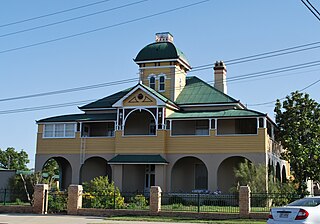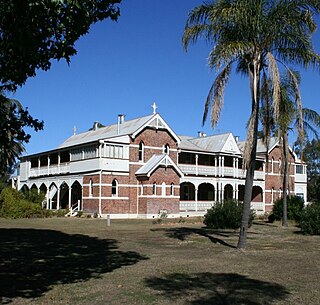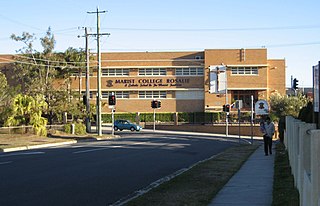
Glengariff is a heritage-listed villa at 5 Derby Street, Hendra, City of Brisbane, Queensland, Australia. It was designed by Hubert George Octavius Thomas, with 1907 alterations by Robin Dods, and built from 1888 to 1889. It is also known as Dura and Glenaplin. It was added to the Queensland Heritage Register on 21 August 1992.

Wairuna is a heritage-listed detached house at 27 Hampstead Road, Highgate Hill, City of Brisbane, Queensland, Australia. It was designed by Robin Dods and built from 1896 to 1900. It was added to the Queensland Heritage Register on 21 October 1992.

Goldicott is a heritage-listed house, set on 1.23 hectares, located at 50 Grove Street, Toowong, Brisbane, Queensland, Australia. It was built from 1885 to c. 1918.

Old Bishopsbourne is a heritage-listed house at 233 Milton Road, Milton, City of Brisbane, Queensland, Australia. It was designed by Benjamin Backhouse and built from 1865 to 1959. It is also known as St Francis Theological College and Bishopsbourne. It was added to the Queensland Heritage Register on 21 October 1992.

Nazareth House is a heritage-listed benevolent institution at 272 Wynnum North Road, Wynnum, City of Brisbane, Queensland, Australia. It was built from 1924 to 1939. It was added to the Queensland Heritage Register on 2 April 2002.

Villa Maria Hostel is a heritage-listed nursing home at 167–173 Saint Paul's Terrace, Fortitude Valley, City of Brisbane, Queensland, Australia. It was designed by Frank Cullen, Hennessy, Hennessy, Keesing & Co, & J P Donoghue and built from 1927 to 1968. It was added to the Queensland Heritage Register on 18 September 2008.

Cremorne is a heritage-listed villa at 34 Mullens Street, Hamilton, City of Brisbane, Queensland, Australia. It was designed by Eaton & Bates and built from 1905 to 1906. It was added to the Queensland Heritage Register on 21 October 1992.

St Brigid's Convent is a heritage-listed former Roman Catholic convent at 9-17 Upper Clifton Terrace, Red Hill, City of Brisbane, Queensland, Australia. It was designed by Eaton & Bates and built from 1902 to 1923. It was also known as Convent of the Annunciation and Red Hill Convent. It was added to the Queensland Heritage Register on 28 March 2003.

La Scala is a heritage-listed detached house at 517 Brunswick Street, Fortitude Valley, City of Brisbane, Queensland, Australia. It was designed by Thomas Ramsay Hall and built c. 1915. It was originally known as Craig Athol. It was added to the Queensland Heritage Register on 21 October 1992.

Our Lady of Assumption Convent is a heritage-listed former Roman Catholic convent at 8 Locke Street, Warwick, Southern Downs Region, Queensland, Australia. It was designed by Simkin & Ibler and built from 1891 to 1914. It is also known as Assumption College, Cloisters, and Sophia College. It was added to the Queensland Heritage Register on 21 October 1992.

St Mary's Presbytery is a heritage-listed Roman Catholic presbytery of St Mary's Roman Catholic Church at 142 Palmerin Street, Warwick, Southern Downs Region, Queensland, Australia. It was designed by Wallace & Gibson and built from 1885 to 1887 by John McCulloch. It is also known as Father JJ Horan's private residence. It was added to the Queensland Heritage Register on 31 July 2008.

Rockhampton Girls Grammar School is a heritage-listed private school at 155 Agnes Street, The Range, Rockhampton, Rockhampton Region, Queensland, Australia. It was designed by Edwin Morton Hockings and built in 1890 by Moir Cousins and Co. It was added to the Queensland Heritage Register on 20 October 2000.

The Range Convent and High School is a heritage-listed private school at 263 Agnes Street, The Range, Rockhampton, Rockhampton Region, Queensland, Australia. It was built from c.1880s to 1930s. It is also known as Our Lady of Good Counsel Convent and School and The Catholic College Residential. It was added to the Queensland Heritage Register on 21 October 1992.

St Patrick's Convent is a heritage-listed Roman Catholic convent at 45 The Strand, North Ward, City of Townsville, Queensland, Australia. It was built in c. 1883. It was added to the Queensland Heritage Register on 3 February 2012.

St Monica's Cathedral is the cathedral of the Catholic Church in the Diocese of Cairns. It is located at 183 Abbott Street, Cairns City, Cairns, Queensland, Australia. The cathedral was designed by Ian Ferrier and built from 1967 to 1968. It was added to the Queensland Heritage Register on 31 August 1998.

Cooktown Museum is a heritage-listed former convent and school and now museum at Furneaux Street, Cooktown, Shire of Cook, Queensland, Australia. It was designed by Francis Drummond Greville Stanley and built from 1888 to 1889 Hobbs & Carter. It was formerly known as St Mary's Convent and School. It was added to the Queensland Heritage Register on 21 October 1992.

St Columba's Convent is a heritage-listed Roman Catholic former convent at 169 Cunningham Street, Dalby, Western Downs Region, Queensland, Australia. It was designed by George Bernard Roskell and built in 1913 by John Draney. It is also known as Iona. It was added to the Queensland Heritage Register on 9 December 2010.

All Hallows' School Buildings are a heritage-listed group of Roman Catholic private school buildings at 547 Ann Street, Fortitude Valley, City of Brisbane, Queensland, Australia. They were designed by a number of notable Brisbane architects and were constructed over many years. The earliest is the All Hallows Convent, also known as Adderton. The buildings were added to the Queensland Heritage Register on 21 October 1992.

Marist Brothers College Rosalie Buildings are heritage-listed Roman Catholic monastery and school buildings at Fernberg Road, Rosalie, City of Brisbane, Queensland, Australia. They are also known as Marist Brothers' Monastery and Marist College. They were added to the Queensland Heritage Register on 18 September 2008.

The Buildings of St Joseph's College, Nudgee is a heritage-listed group of school buildings at St Joseph's College, Nudgee at 2199 Sandgate Road, Boondall, City of Brisbane, Queensland, Australia. They were built from 1891 to c. 1960. The school is also known as Nudgee College and St Joseph's Nudgee College. The buildings added to the Queensland Heritage Register on 6 November 2006.























